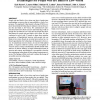Free Online Productivity Tools
i2Speak
i2Symbol
i2OCR
iTex2Img
iWeb2Print
iWeb2Shot
i2Type
iPdf2Split
iPdf2Merge
i2Bopomofo
i2Arabic
i2Style
i2Image
i2PDF
iLatex2Rtf
Sci2ools
ASSETS
2015
ACM
2015
ACM
Exploring the Opportunities and Challenges with Exercise Technologies for People who are Blind or Low-Vision
People who are blind or low-vision may have a harder time participating in exercise due to inaccessibility or lack of experience. We employed Value Sensitive Design (VSD) to explore the potential of technology to enhance exercise for people who are blind or low-vision. We conducted 20 semistructured interviews about exercise and technology with 10 people who are blind or low-vision and 10 people who facilitate fitness for people who are blind or low-vision. We also conducted a survey with 76 people to learn about outsider perceptions of hypothetical exercise with people who are blind or low-vision. Based on our interviews and survey, we found opportunities for technology development in four areas: 1) mainstream exercise classes, 2) exercise with sighted guides, 3) rigorous outdoors activity, and 4) navigation of exercise spaces. Design considerations should include when and how to deliver auditory or haptic information based on exercise and context, and whether it is acceptable to dev...
| Added | 16 Apr 2016 |
| Updated | 16 Apr 2016 |
| Type | Journal |
| Year | 2015 |
| Where | ASSETS |
| Authors | Kyle Rector, Lauren R. Milne, Richard E. Ladner, Batya Friedman, Julie A. Kientz |
Comments (0)

